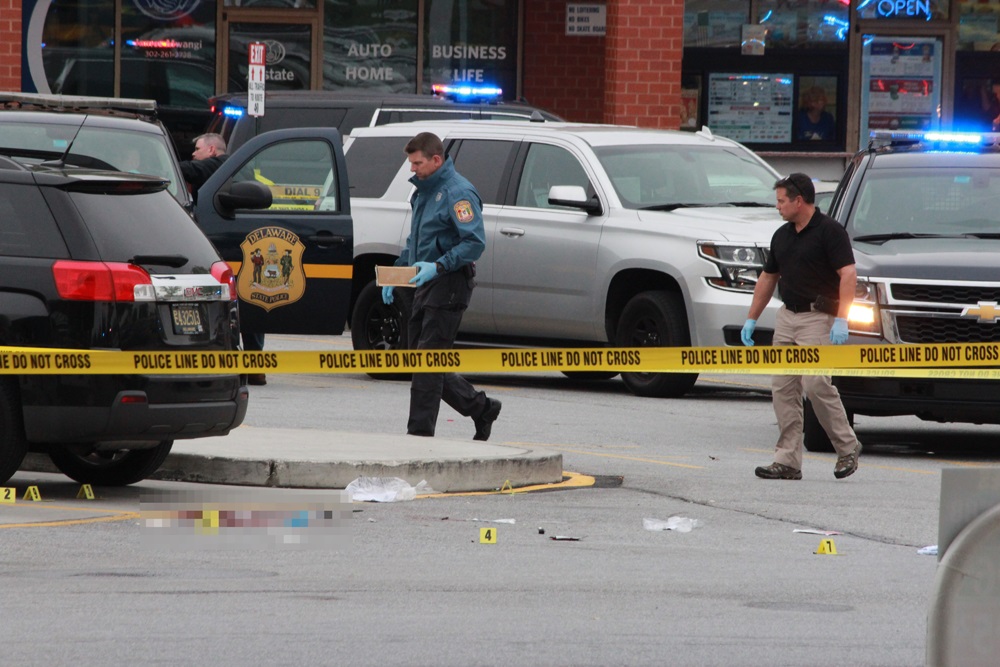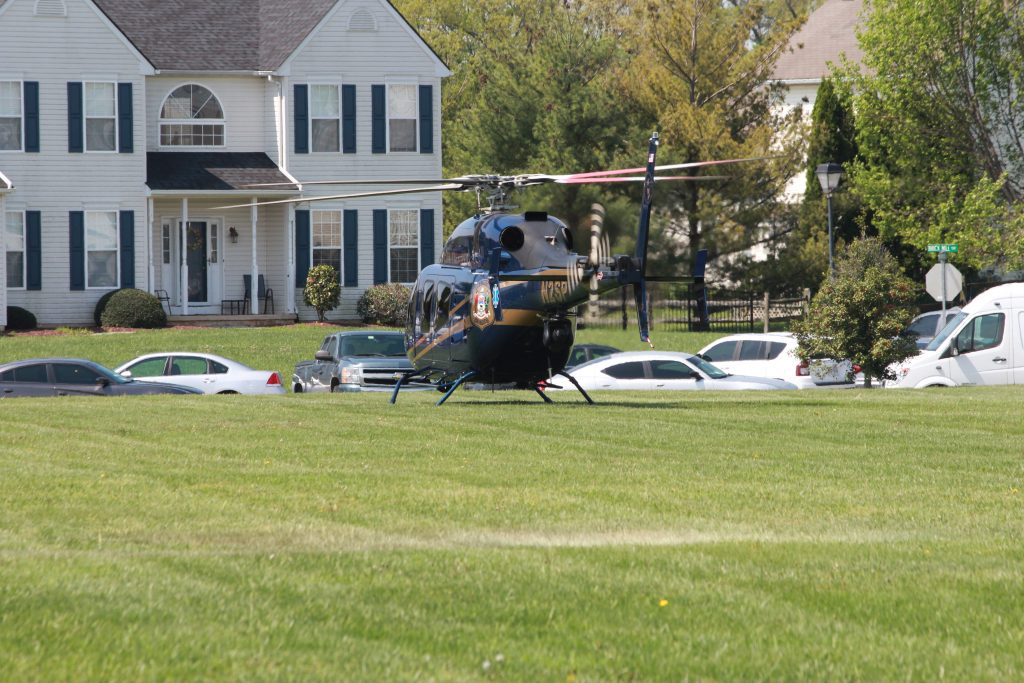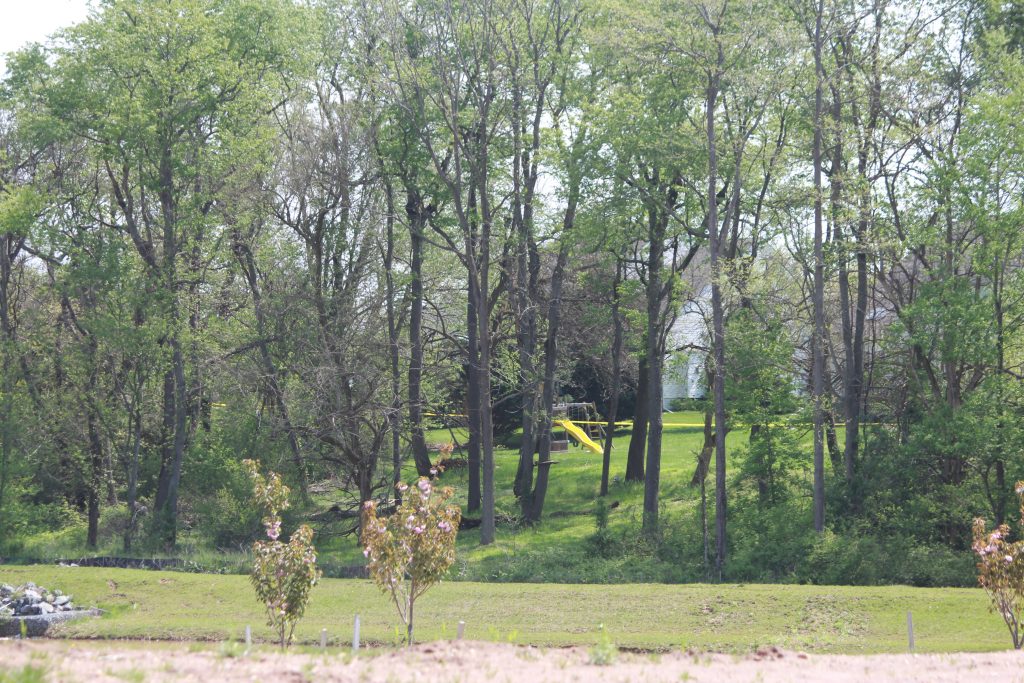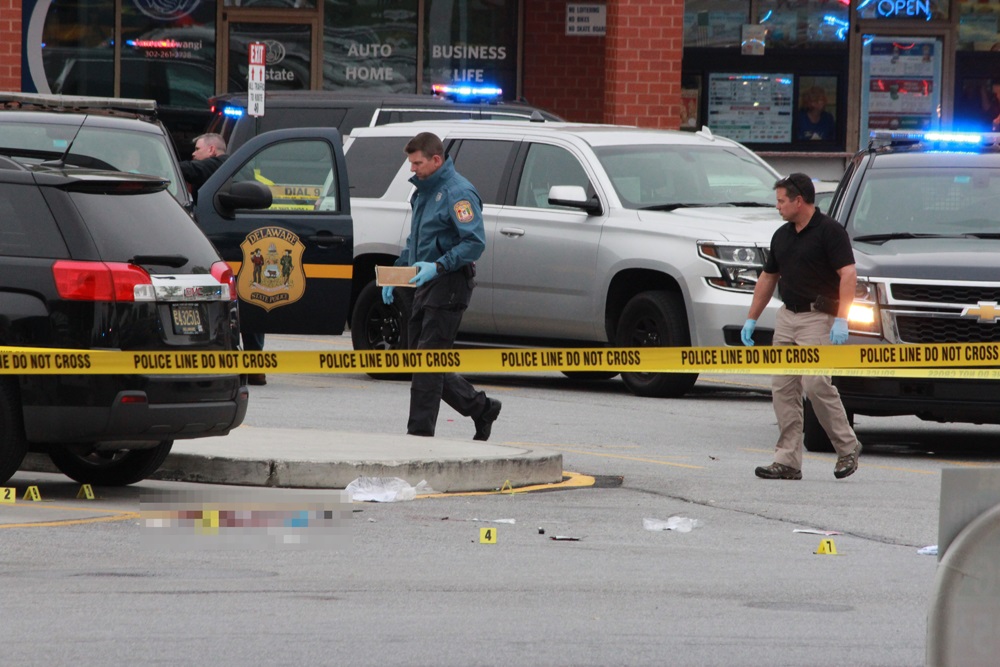
This is the final report of the Delaware Department of Justice, Office of Civil Rights and Public Trust, on the investigation of the use of force by multiple officers from the Delaware State Police Department (“DSP”), the New Castle County Police Department (“NCCPD), the Wilmington Police Department (“WPD”) and the Federal Bureau of Investigation (“FBI”) against Burgon Sealy, Jr. (referred to hereinafter as “Mr. Sealy”). Investigators from the Office of Civil Rights and Public Trust examined the crime scene and reviewed evidence, including audio and video evidence, reports written by officers who responded to the scene and witness interviews. Attorneys with the Office of Civil Rights and Public Trust reviewed this use of force incident for the Department of Justice.
[media-credit name=”As the authorities opened fire on the suspect these officers ran out of the woods to take cover. This image was captured just minutes after the incident.” align=”aligncenter” width=”1024″]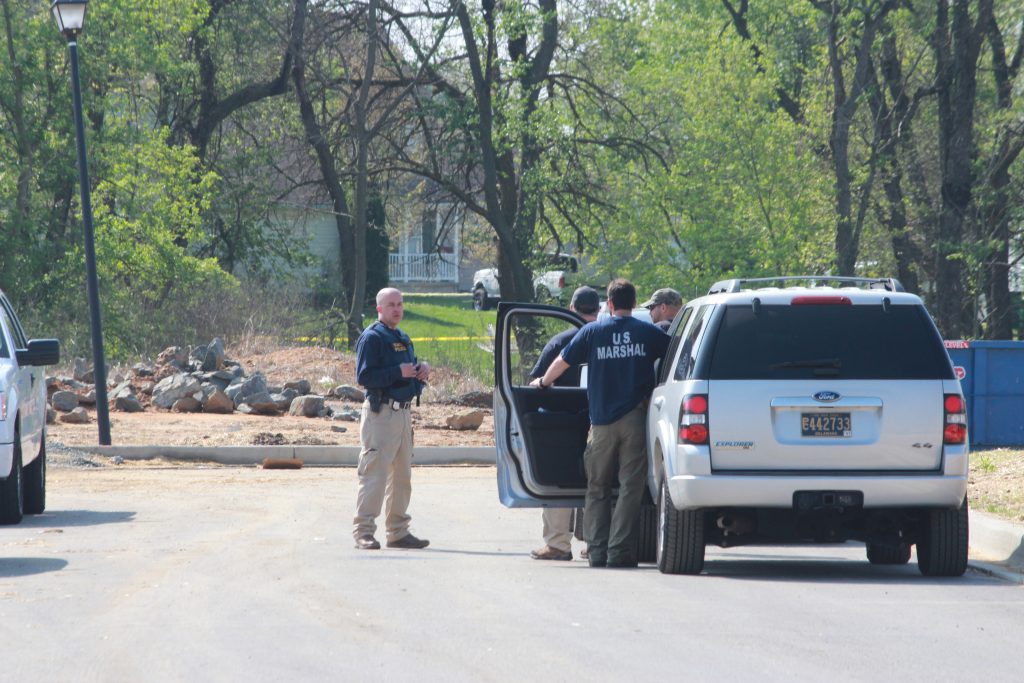 [/media-credit]
[/media-credit]
On Wednesday, April 26, 2017 at approximately 12:05 p.m., DSP Corporal Stephen Ballard was on routine patrol and responded to the Wawa on Pulaski Highway. Corporal Ballard approached the driver of a suspicious vehicle backed into a space on the side of the Wawa in the parking lot. Corporal Ballard asked the driver for identification and the driver complied. He then went to the passenger side of the vehicle and asked the passenger for identification. The passenger was sitting in the car with the door open. He had one foot outside of the vehicle and asked why he had to give identification. The passenger gave Corporal Ballard his identification and Corporal Ballard asked him to step out of the car. As he got out of the car, the passenger began to struggle with Corporal Ballard and witnesses heard shots. As Corporal Ballard attempted to take cover, the passenger followed Corporal Ballard and fired additional rounds at Corporal Ballard at close range after Corporal Ballard fell to the ground (Facts of encounter provided by the driver of the vehicle and witness statements.). Corporal Ballard died from his injuries. Police positively identified the suspect as Burgon Sealy, Jr., who lived on St. Michael Drive in Middletown, Delaware. Burgon Sealy, Sr., also provided additional information, notifying the police that his son called him and said that he shot an officer at the Wawa. Burgon Sealy, Sr., advised police that his son told him that he was at the house in Middletown where he and his father lived and stated that he would shoot and kill anyone that came to the residence.
DSP activated its Special Operations Response Team (SORT) and NCCPD activated its Special Weapons and Tactics (SWAT) team. Officers from DSP and NCCPD responded to the St. Michael Drive residence to conduct surveillance on the residence for any signs of Mr. Sealy. At approximately 1:30 p.m., the SORT arrived on scene in a motorcade of vehicles, including an armored Lenco Bear Cat (An armored tactical vehicle, which provides an enhanced level of protection for occupants from hostile weapon fire). The SORT immediately began taking a high volume of rifle fire from a second floor window of the residence. A DSP Trooper, who had arrived in a separate police vehicle, and positioned himself on the driveway side of the house, was forced to exit his vehicle and take cover behind his vehicle’s engine compartment as Mr. Sealy fired numerous rounds, striking the vehicle multiple times. Tree branches struck by the rifle fire fell around the Trooper who was able to identify the window that Mr. Sealy was firing from but could not return fire without the risk exposing himself to the rifle fire coming from the window. As the Bear Cat got close enough for the Trooper to get safely inside, Mr. Sealy continued firing at the Bear Cat and its occupants. Due to the high volume of fire directed at them by Mr. Sealy, the officers could not open any hatches on the Bear Cat to return fire.
NCCPD SWAT arrived on scene shortly thereafter and Mr. Sealy continued to fire on them from the residence with heavy rifle fire. Numerous rounds struck police vehicles from DSP and NCCPD. Officers could not see Mr. Sealy inside the residence but could see the muzzle flashes. Due to the rapidly evolving situation, NCCPD SWAT deployed chemical agents into the residence in an effort to impair or dislodge Mr. Sealy from his position. A DSP Corporal returned fire from his departmental issued rifle into the window from which Mr. Sealy was firing shots in an effort to end the deadly threat Mr. Sealy posed to the officers on the scene.
After a period, Mr. Sealy stopped firing and police undertook efforts to convince him to surrender. During calls with his father, Mr. Sealy told his father that none of the police gunfire struck him. He also told his father “I’m gonna die today. I got this, I don’t know if you know what the f**k went on but I think I just killed maybe two or three more cops. I been shooting out this f**king window with the AR-15 for a while. All the police are gone. They shot tear gas in the house. I put my asbestos glass on and all of that.” He also told his father that he was “really hoping [he would] go now” and “didn’t know if [he] should just walk outside right now and start shooting and go out in a blaze of glory or wait here.” During a call with his mother, he also told her that he shot a cop and was not going to jail. Police continued their efforts to contact Mr. Sealy by phone and loudspeaker throughout the evening and night. On several occasions he answered the phone but hung up, other attempts went to voice mail. All meaningful communication with Mr. Sealy ended in the early evening.

During the nighttime hours, members of the FBI Hostage Rescue Team (“HRT”) arrived on scene and assisted with tactical operations. They deployed a tactical team to the rear of the residence in a Bear Cat and positioned team members in nearby locations. Additional tactical operations were undertaken to dislodge or expose Mr. Sealy, including explosively breaching the front door of the residence and dismantling the garage door of the residence. After breaching the entrances, law enforcement robots were sent into the residence in an effort to locate Mr. Sealy. Police also deployed aerial drones around the residence.
WPD’s SWAT team was also on scene and moved their Bear Cat armored vehicle into position near the residence. During the early morning hours, at approximately 4:00 a.m., WPD navigated their robot to the second floor of the residence. Mr. Sealy fired numerous rounds at the robot disabling it. HRT perimeter officers reported hearing Mr. Sealy reload his weapon after the gunfire ceased. Police resumed breaching operations in an effort to expose or dislodge Sealy. Shortly after, at approximately 4:30 a.m., officers on scene heard a single gunshot from inside the residence.
The Pennsylvania State Police (“PSP”) responded to the scene with their ROOK to assist with the operation. The PSP Rook began pulling down the exterior of the second floor rear bedroom on the side of the residence to allow officers a better view into the bedroom to confirm whether Mr. Sealy was still alive. At approximately, 9:16 a.m., Mr. Sealy fired numerous rounds from the first floor of the residence striking the Rook but not the PSP Trooper operating it.
Moments later, perimeter officers reported that Mr. Sealy was moving to the front door of the residence. Mr. Sealy exited the residence wearing a protective respirator and holding a gun in his right hand as he turned and walked in the direction of tactical personnel stationed on St. Michael Drive. Multiple officers from the involved agencies simultaneously discharged their weapons striking Mr. Sealy. Those officers are DSP Corporal Joshua Scaramazza, WPD Sergeant Thomas Looney, WPD Master Corporal Jason Dolinger, WPD Master Corporal David Simmons, WPD Sergeant Joseph Leary, NCCPD Detective Brian Lucas, NCCPD Senior Corporal Bruce Ashby, NCCPD Sergeant Daniel Guzevich and 3 FBI HRT members.
Mr. Sealy fell to the ground on his back dropping the gun in his right hand. After he fell, he appeared to be reaching for another handgun in his waistband. As a result, the primary officers fired additional shots. After the shooting ceased, the FBI tactical team approached Mr. Sealy. DSP SORT members moved in and handcuffed Mr. Sealy. Paramedics pronounced Mr. Sealy dead at the scene. Police recovered a Glock 17 (loaded with 5 rounds of ammunition) and a Glock 19 (loaded with 23 rounds of ammunition) from the yard where Mr. Sealy fell to the ground. They also recovered an MP15 Rifle, a Glock 26, a .45 Taurus handgun, and a 9mm Taurus in various rooms in the residence along with 187 shell gun casings that were a mix of rifle and handgun casings.
Conclusion
After a thorough investigation and review of all statements and reports, it is the conclusion of the Department of Justice that, as a matter of Delaware law, the use of force by the officers from the involved agencies was not a criminal act because the use of such force against Mr. Sealy was justified. Section 464 of Title 11 of the Delaware Code generally defines the legal use of force in self-protection. It provides, in pertinent part, that “[t]he use of force upon or toward another person is justifiable when the [officer] believes that such force is immediately necessary for the purpose of protecting the [officer] against the use of unlawful force by the other person on the present occasion.” Additionally, Section 465 of Title 11 of the Delaware Code defines the use of force for the protection of other persons. It provides that, “[t]he use of force upon or toward another person is justifiable to protect a third person when the [officer] would have been justified under 464 of this title in using force to protect the [officer] against the injury the [officer] believes to be threatened to the person whom the [officer] seeks to protect.”
Under Delaware law, each officer’s subjective state of mind is of critical importance in determining whether his use of force was justifiable. The specific factual inquiry is two-pronged. The first question is whether the officer actually believed, at the time he intentionally fired his weapon, that such action was necessary to protect himself or others from death or serious physical injury. The second question is whether the officer was reckless or negligent in having such belief, or in acquiring or failing to acquire any knowledge or belief, which is material to the justifiability of the use of force. 11 Del. C. § 470(a).
Multiple law enforcement agencies responded to apprehend a suspect who had just shot and killed a Delaware State Trooper. Police quickly identified the suspect as Mr. Sealy who told his father that he shot a police officer at the Wawa. Mr. Sealy also made it known that he would shoot and kill anyone who came to the house in Middletown where he had barricaded himself and, in fact, immediately began firing on officers in vehicles responding to the scene. During conversations with this father, he indicated that he thought he had killed two or three additional police officers with rifle fire from his AR-15. Police unsuccessfully tried to get Mr. Sealy to surrender throughout the night. Police attempted to enter the house with a robot to locate Mr. Sealy. Mr. Sealy responded by firing numerous rounds at the robot disabling it. Officers also heard Mr. Sealy reloading his weapon. At approximately 4:30 a.m., officers on scene heard a single gunshot from inside the residence.
At approximately 9:16 a.m., Mr. Sealy resumed shooting at police, firing shots at the PSP Rook and its occupants as they attempted to tear down a wall to obtain a view into the residence to confirm whether Mr. Sealy was still alive. Shortly thereafter, rather than surrender, Mr. Sealy made the choice to exit the residence displaying a handgun as he moved toward officers on the scene, causing officers to engage fire.
Mr. Sealy had already killed one officer and repeatedly attempted to kill others during their encounter with him as he fired his weapons from inside the residence. He refused to surrender and officers were aware that he talked about going out in in a “blaze of glory.” Officers who discharged their weapons stated that when Mr. Sealy exited the residence with the gun in his hand, he moved toward them purposefully and aggressively with a determined walk. They believed that he intended to shoot his weapon and try to kill them as he did so. Officers who provided voluntary interviews stated that they were in fear for their safety and the safety of other officers when they discharged their weapons. At the time deadly force was used against Mr. Sealy it was objectively reasonable, based on the facts available to each of the officers who discharged their weapons, to conclude that Mr. Sealy intended to discharge his firearm in their direction again.
The investigation of the facts and circumstances fully support the reasonableness of each officer’s belief that his life or the lives of others were in danger. That belief was not formed recklessly or negligently. As a result, the use of deadly force was justified and therefore not subject to criminal prosecution.

